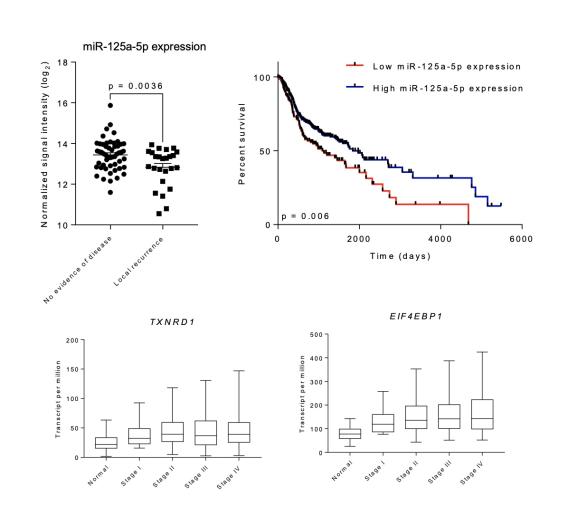MicroRNAs (miRNAs) are short single-stranded RNAs that measure 21 to 23 nucleotides in length. They regulate gene expression at the post-transcriptional level through mRNA destabilization or repressing protein synthesis. Dysregulation of miRNAs can lead to tumorigenesis through changes in regulation of key cellular processes such as cell proliferation, cell survival, and apoptosis. Our project aims are to find and functionally characterize diagnostic and prognostic miRNA markers in high risk advanced head and neck (HN) cancer. We performed microRNA microarray profiling of HNSCC tumor samples obtained from a prospective clinical trial that is evaluating the role of postoperative radiotherapy in HN cancer. miRNA microarray results revealed that miR125a-5p is down regulated in locoregional recurrence (LR) group tumor samples and miR551a and miR-551b-3p are upregulated in distant metastasis (DM) group tumor samples compared to no evidence of disease (NED) group tumor samples. Further functional characterization studies showed that miR-125a-5p acts as a tumor suppressor miRNA, which targets the expression of ERBB2, EIF4EBP1, and TXNRD1. We then showed that miR-125a-5p regulates cell proliferation through cell cycle regulation at the G1/S transition. We also showed that miR-125a-5p can alter cell migration and modulate sensitivity to ionizing radiation. miR-551a and miR-551b-3p potentially function as oncogenic miRNAs and regulate cell proliferation, cell migration, and cell invasion. Moreover, miR-551a and miR-551b-3p regulate sensitivity to ionizing radiation. Finally, we showed that miR-551a and miR-551b-3p directly target the GLIPR2 mRNA, which encodes for a protein that is a negative regulator of autophagy.
Publications:
- Vo D*, Karanam NK*, Ding L, Saha D, Yordy JS, Giri U, Heymach JV and Story MD (2019). miR-125a-5p functions as tumor suppressor microRNA and is a marker of locoregional recurrence and poor prognosis in head and neck cancer. Neoplasia. (*Equal first author.)
- Karanam NK, Ding L, Hwang TH, Tang H, Story MD. miR-551a and miR-551b target GLIPR2 and promote tumor growth in High-Risk Head and Neck Cancer by modulating autophagy. BioRxiv.
